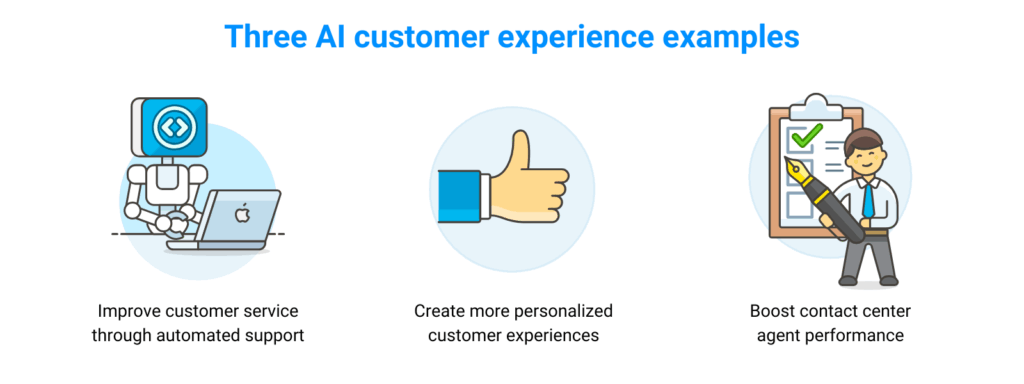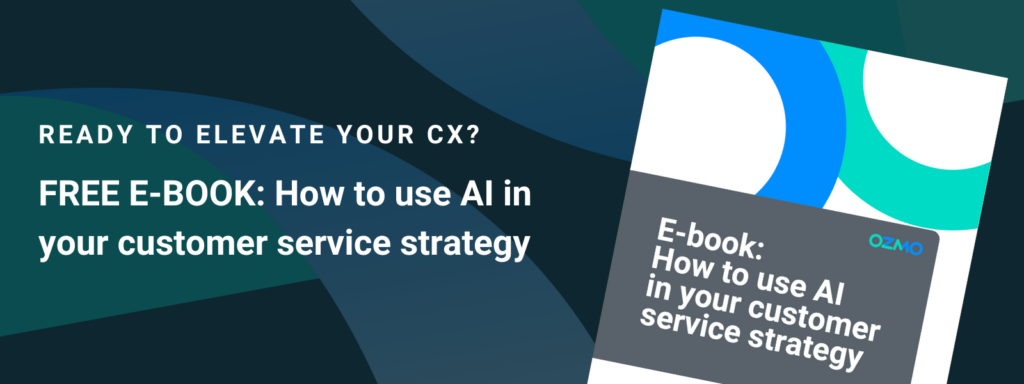If you’re not prioritizing the customer experience (CX), you’re leaving money on the table. Over half of customers say they’re willing to pay more for better service. Yet, only eight percent of customers say companies provide good customer experiences.
That last number can be startling. After all, it means that most customers aren’t happy with their current service provider. So, how can you ensure that all your customers have a great experience when serving millions of people?
The key is to lean into technology, such as artificial intelligence (AI). AI can help your broadband or telecom business deliver exceptional tech support, whether you’re a regional service provider (RSP) or nationwide carrier.
So, how can you leverage AI in your customer service strategy? Below, we go over a few AI customer experience examples you can apply to your own business.
First, what is artificial intelligence (AI)?
In the simplest terms, artificial intelligence, or AI, refers to using machines to solve problems. While most of us probably hadn't heard of AI until ChatGPT burst onto the scene in 2022, the concept is far from new.
In fact, the first discussions of AI can be traced back to the 1950s. Alan Turing, a British mathematician considered the father of AI, developed a test to assess a computer's ability to think. His Turing Test, as it has come to be known, is still used in AI innovation today.
There are many examples of AI that you use in your everyday life. You may use a tool like Grammarly to edit a memo before you send it off to your team. Or, you use facial recognition to unlock your phone. You may have even taken a self-driving taxi back to your house after a night out. All of these are examples of how AI has become an integral part of our daily lives.
What is customer experience (CX)?
If you read three different sources to define customer experience, you’re likely to get three different answers. However, generally, when we talk about customer experience, we’re referring to everything a customer sees and feels when interacting with your brand. In other words, their experience every time they reach out for tech support, buy a product, use the self-service portal or interact with your company in some way.
The customer experience begins when someone first discovers your brand. However, it doesn’t end after they buy your products or sign up for a subscription service. Customer experience continues well beyond the purchase stage of the customer journey to foster customer loyalty and retention.
Why prioritize customer experience: The case for telecom and broadband
Customer experience is key to differentiation in broadband and telecom as more companies enter the market. Customers are unforgiving with businesses that fail to meet their expectations. 96% of customers say they’ll leave a brand after one bad service experience.
A high customer churn rate can have a devastating impact on your company’s profitability. It’s estimated that poor customer service costs businesses up to $1.6 trillion each year. Additionally, data shows it can cost up to seven times more to acquire new customers than to retain your current clients. With numbers like these, it’s shocking that many business leaders regard customer service as an afterthought.
However, there is a silver lining. Since you’re aware of just how necessary the customer experience is, you can focus on ensuring customers have a smooth interaction at every touchpoint on their journey.
Not only does this reduce customer churn, but it can also position you as an alternative for customers who are fed up with your competitors. Seven out of 10 customers say customer experience is a key factor in purchasing decisions. Focusing on good CX not only helps you improve your customer retention rate but can also help you stand out from the competition.
AI customer experience examples for telecom and broadband providers
Prioritizing the customer experience is key for companies that want to stand out in increasingly saturated markets. Below, we go over three AI customer experience examples you can implement in your telecom or broadband business.

Example one: Improve customer service through automated support
Automated support isn’t just about cutting costs. Implementing self-service creates a better customer experience.
How? First and foremost, 88% of customers expect you to provide self-service options. That means that automated support is no longer a nice-to-have, but a must-have for good CX. The foundation of creating good customer experiences is giving customers what they want.
Yet, the key isn’t just to do self-service, but to do it well. There are many good customer experience examples in telecom and broadband that involve the adoption of AI. For example, conversational AI chatbots can be a powerful tool for improving tech support.
There are many benefits of using chatbots in customer service. The most critical benefit is that they allow customers to skip long call center queues and access instant support. Today’s chatbots can go beyond basic FAQ pages. That’s because many use large language models (LLMs) to understand the nuances of customer requests better. This allows them to provide more accurate troubleshooting and issue resolution.
Additionally, while people need to sleep, chatbots never do. This means your customers can access the tech support they need at any time of day or night. However, that said, it’s important to be clear: AI can’t replace human agents. Instead, a good customer experience strategy implements a combination of human interaction and automated support to scale effectively and meet customer needs.
Example two: Create more personalized customer experiences
There are many advantages of personalized customer service. Over three-fourths of customers are frustrated by the lack of personalized interactions with brands.
At the same time, 60% of customers say businesses aren’t providing tailored customer experiences. That means creating personalized tech support experiences allows you to strongly position your company to stand out from the competition in attracting and retaining new customers.
How do you tailor the customer service experience when you have thousands, or millions, of customers? AI can help personalize customer experiences at scale.
One way to do this is by providing multilingual self-service options. Most telecom and broadband companies serve customers who speak multiple languages. In the U.S., many companies offer tech support in Spanish and English. However, according to the Census Bureau, many people also speak Tagalog, Vietnamese and Arabic.
Therefore, telecom and broadband service providers would also benefit from ensuring automated support tools, such as interactive tutorials, are available in these languages. This helps eliminate friction by ensuring customers can access the help they need in their preferred language.
You can also use AI to provide specific recommendations to customers based on previous interactions with your business. For example, if you know a customer is an avid Android user, you don’t want to send them updates about the latest iOS release. Instead, AI might suggest a compatible accessory for their new Google Pixel phone.
The bottom line? Using AI is vital for personalization at scale. Personalized tech support creates the experience your customers crave, and is a powerful competitive edge.
Example three: Improve contact center agent performance
For most company leaders, the link between agent performance and customer experience is a no-brainer. One critical way you can improve the customer experience is by leveraging AI to improve call center agent productivity.
In fact, a study by the National Bureau of Economic Research showed that access to generative AI improved contact center agent productivity by an average of 14%. The results were even more dramatic for new or underperforming agents, with an average improvement of 34%.
As a result, your agents can work smarter, not harder. When agents are empowered to serve customers more effectively, the customer experience improves. Telecom and broadband leaders looking to leverage AI should consider using it to enhance contact center agent onboarding, thereby shortening the learning curve for new hires.
Implementing AI tools as part of agent training ensures agents have access to reliable and accurate tech support, helping them resolve tech support inquiries faster and become more confident in their work. It also allows more experienced agents to focus on their caseload versus juggling their work alongside training new team members.
Harness the power of AI to level up your CX strategy
AI is quickly becoming a vital tool for most areas of business, and customer service is no exception. Implementing AI technology in your tech stack can help your business reduce friction, streamline the customer experience and foster customer loyalty. By applying some of the examples here to your own CX strategy, you can be well on your way to differentiating your brand from the competition.
Looking for more guidance on using AI to level up your CX? Check out our free e-book, How to use AI in your customer service strategy. This guide explores the role of AI in the modern contact center, including best practices for implementation, key benefits and future trends. Download your copy today.




